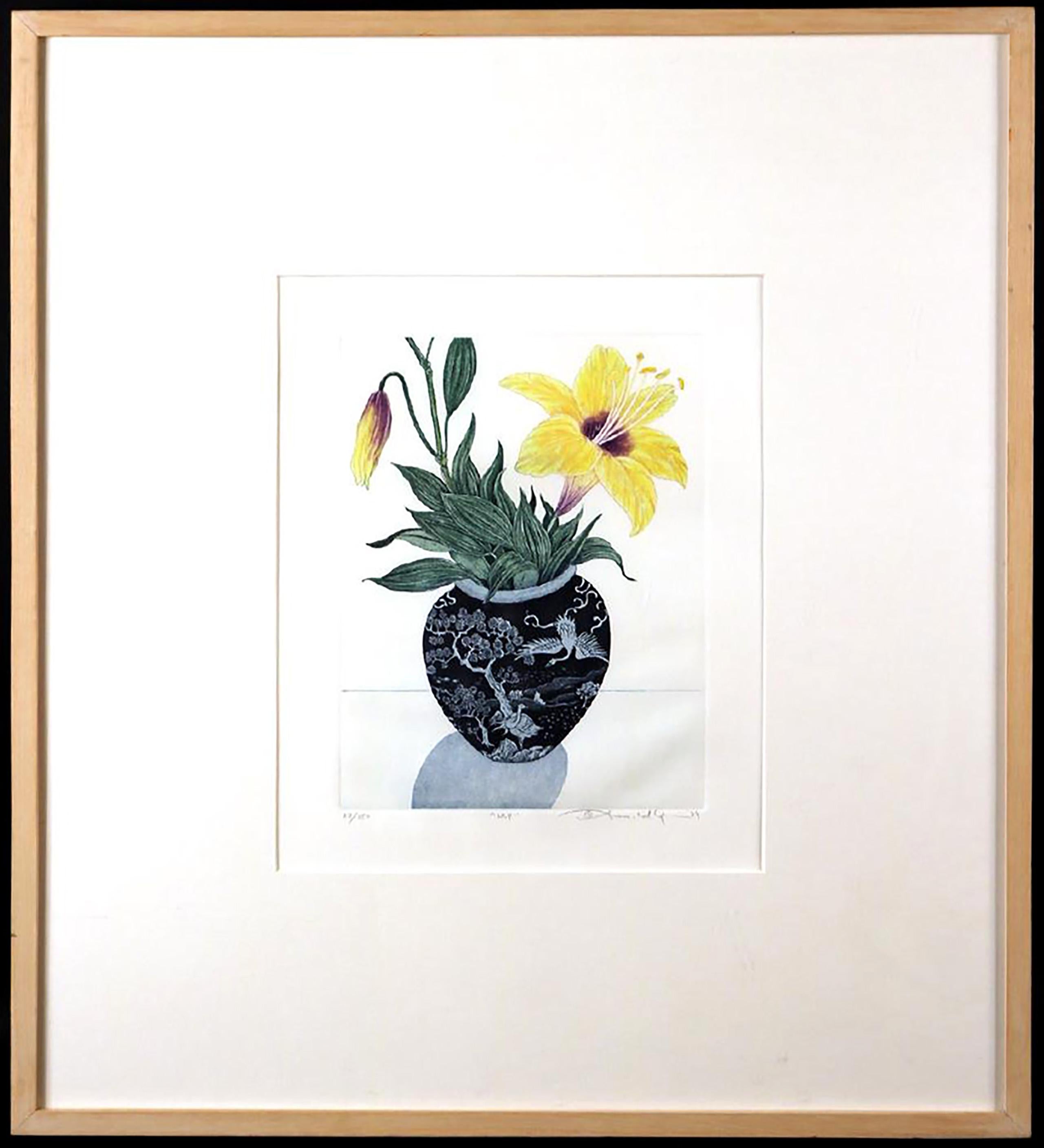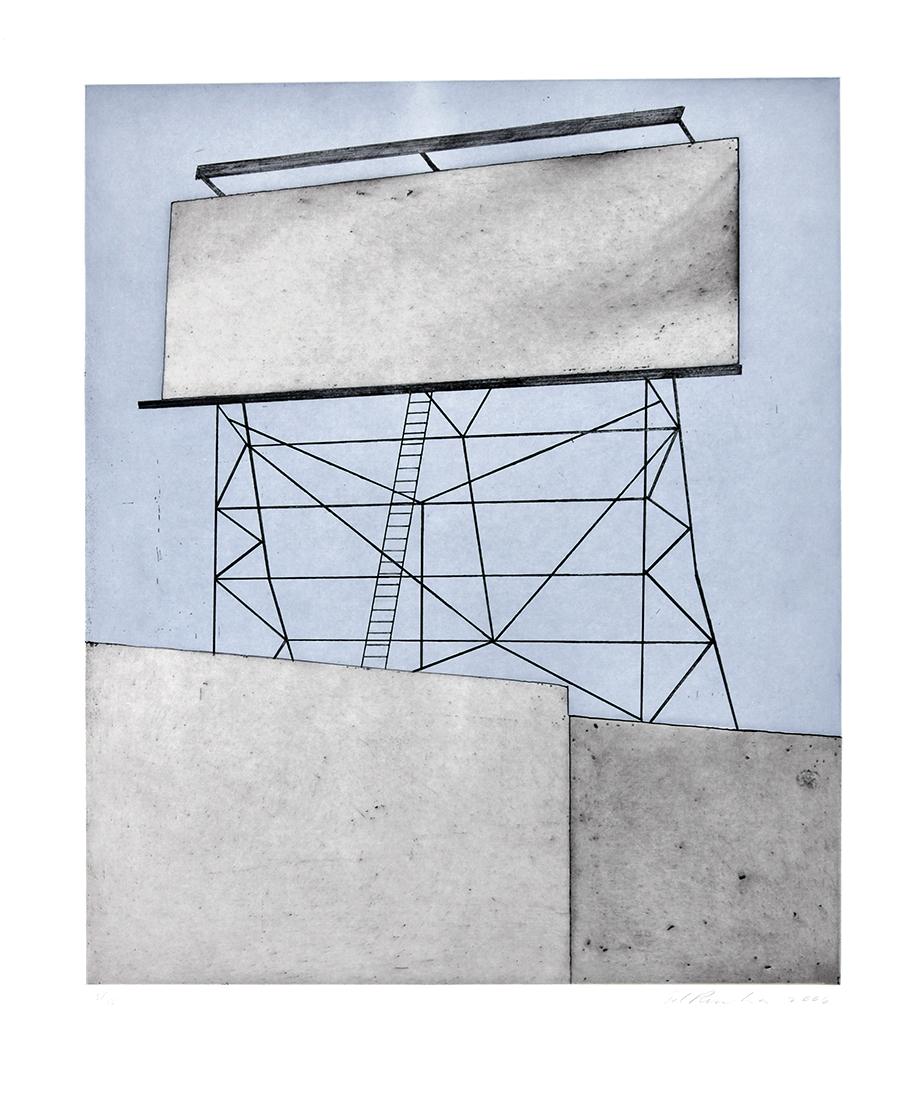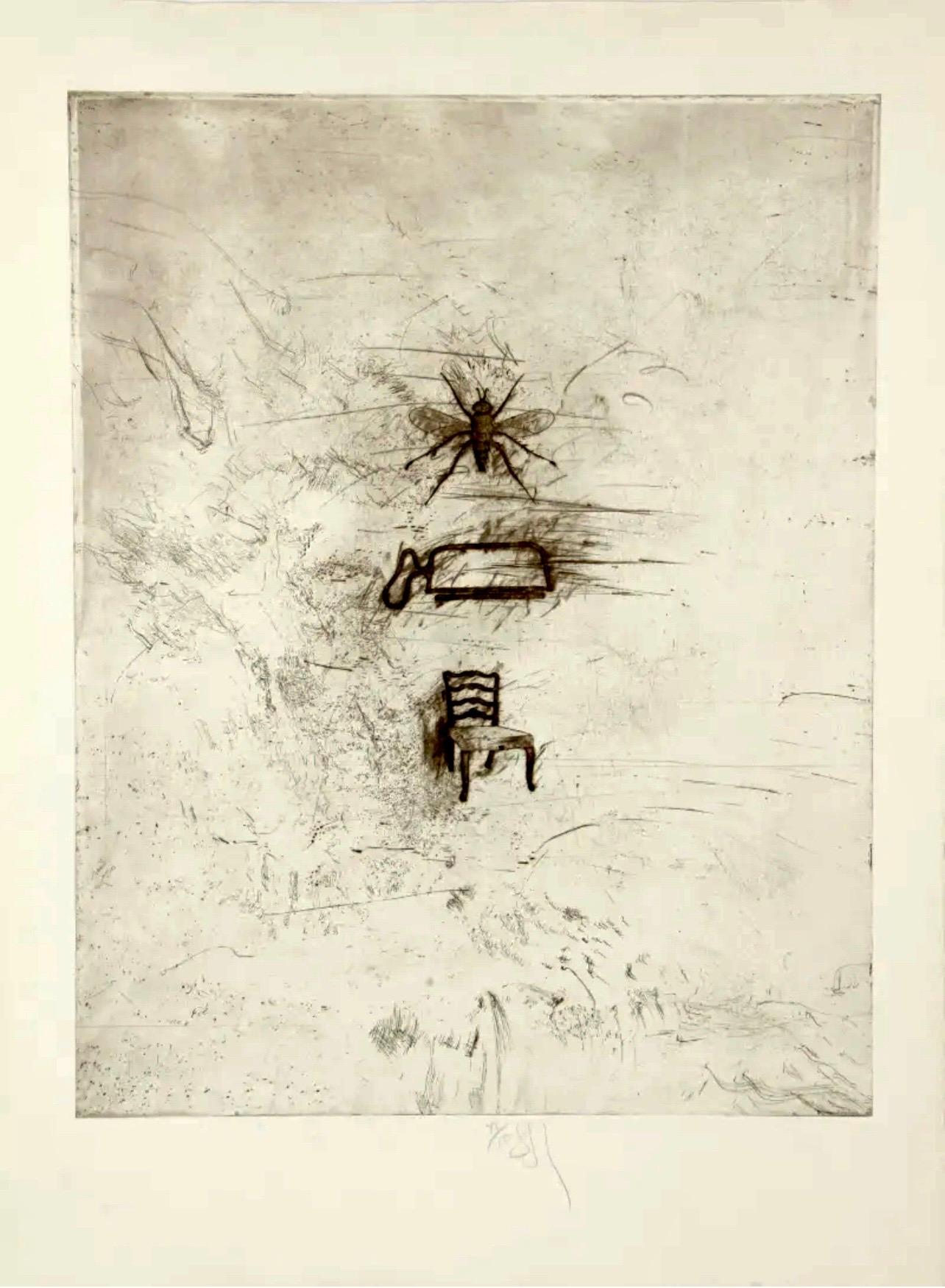Items Similar to George Brookshaw's Black Frontiniac Wine Grape Aquatint from "Pomona Brittanica"
Want more images or videos?
Request additional images or videos from the seller
1 of 8
George BrookshawGeorge Brookshaw's Black Frontiniac Wine Grape Aquatint from "Pomona Brittanica"1804
1804
About the Item
George Brookshaw's (1751-1823) beautiful Black Frontiniac Wine Grape hand-colored aquatint engraving, plate XVII from his "Pomona Brittanica", considered to be the finest British botanical large format treatise of the 19th-century. His engravings were unique for their rich tones and colors, elegant compositions with the fruit seeming to float on a rich mottled background.
The print is presented in a gold and burgundy-colored wood frame and a light gray mat. The print is in very good condition.
Another Brookshaw engraving from his series of fruit illustrations is available on 1stdibs. It is framed and matted identically to this one. It can be viewed on our 1stdibs storefront by typing Timeless Intaglio in the search field and tapping the drop-down name or by searching for item # LU117324346651. The pair would make for an outstanding attractive display. A discount is available for the purchase of the pair.
George Brookshaw (1751-1823) was a respected English painter and illustrator. who began his career as a London cabinet-maker specializing in painted furniture, frequently adorned by flowers. He went on to become a still-life natural history painter. Brookshaw published manuals on techniques of illustrating botanical and bird subjects. His books included "A New Treatise on Flower Painting, or, Every Lady Her Own Drawing Master", published in 1818 and "Pomona Brittanica". Brookshaw's 'Pomona' and Dr. Robert Thornton's 'Temple of Flora' are considered to be the finest British botanical works from the 19th century, the pinnacle of botanical illustrations.
- Creator:George Brookshaw (1751 - 1823, British)
- Creation Year:1804
- Dimensions:Height: 25.88 in (65.74 cm)Width: 21.88 in (55.58 cm)Depth: 0.5 in (1.27 cm)
- Medium:
- Movement & Style:
- Period:
- Condition:
- Gallery Location:Alamo, CA
- Reference Number:
About the Seller
5.0
Vetted Seller
These experienced sellers undergo a comprehensive evaluation by our team of in-house experts.
Established in 2011
1stDibs seller since 2019
233 sales on 1stDibs
Typical response time: 1 hour
- ShippingRetrieving quote...Ships From: Alamo, CA
- Return PolicyA return for this item may be initiated within 7 days of delivery.
More From This SellerView All
- 18th C. Piranesi Fireplace Designs based on Ancient Architectural StylesBy Giovanni Battista PiranesiLocated in Alamo, CAThese two Giovanni Battista Piranesi 18th century etchings of fireplace designs on one sheet is plate 6 from his publication 'Diverse Maniere d'adornare i cammini ed ogni altra parte degli edifizi desunte dall'architettura Egizia, Etrusca, e Greca con un Ragionamento Apologetico in defesa dell'Architettura Egizia, e Toscana, opera del Cavaliere Giambattista Piranesi...Category
Mid-18th Century Old Masters Figurative Prints
MaterialsEtching
- Pair of Hand-colored Romantic French Engravings after Francois BoucherBy (After) Francois BoucherLocated in Alamo, CAA pair of French classical romantic prints original created in the 18th century by Jacques-Firmin Beauvarlet (1731-1797) after paintings by Francois Boucher (1703-1770), utilizing ...Category
18th Century Romantic Figurative Prints
MaterialsEngraving, Etching
- Ancient Roman Architectural Frieze: An 18th C. Piranesi EtchingBy Giovanni Battista PiranesiLocated in Alamo, CAThis framed original 18th century etching is entitled "Fregio antico di marmo con Ippogrifi, nel cortile del palazzo della Valle" (Ancient Marble Frieze with Hippogriffs in the Courtyard of The Palace of the Valley). The etching is by Giovanni Battista Piranesi, published in Rome in 1778. It is from Piranesi's monumental work "Vasi, Candelabri, Cippi, Sarcofagi, Tripodi, Lucerne, Ed Ornamenti Antichi", (Vases, candelabra, grave stones...Category
Early 18th Century Old Masters Figurative Prints
MaterialsEtching
- Flowering Iris & Other Botanicals: Framed 17th C. Besler Hand-colored EngravingLocated in Alamo, CAThis is a hand-colored copper-plate engraving entitled "I. Spatula foetida - II. Caucalis Dodonei - III. Cruciata", depicting three flowering plants, including an Iris, from Basilius Besler's landmark work, Hortus Eystettensis (Garden at Eichstatt), first published in 1613 in Eichstatt, Germany near Nuremberg and later in 1640 and 1713. This beautiful hand-colored botanical engraving is presented in a gold-colored wood frame with a French mat...Category
Mid-17th Century Academic Still-life Prints
MaterialsEngraving
- Redoute Hand-colored Engraving of Cactus Flowers "Cactus Peruvianus Cierge"By Pierre-Joseph RedoutéLocated in Alamo, CAThis framed hand-colored stipple engraving entitled "Cactus Peruvianus Cierge du Pérou" by Pierre-Joseph Redouté, Plate 58 from his illustrated publication 'Plantarum Historia Succulentarum ou Histoire des Plantes Grasses', published in Paris in 1799. It depicts a branching limb of a cactus with a beautiful flower. There is a separate detail of the anatomy of a seed with early growth. Redoute was a pioneer of the stipple engraving technique, which he used to create this image. It involves utilizing a series of small dots worked into a copper plate rather than the more common lines. These dots can be made smaller or thicker depending on the degree of opacity the artist intends for various areas of the print. When inked and applied to paper, this allows for a greater portion of the paper to be seen, which accentuates the appearance of luminosity of the subject the artist is creating. Different color inks are used in the printing process, a time consuming technique known as "a la poupee". The engraving is then finished with watercolor to further enhance the beauty and realism of the print subject. This engraving of a flowering cactus is presented in silver-colored ribbed wood frame and a double mat; cream-colored outer mat and heather green inner mat. The frame measures 21.25" high by 17.25" wide by 1.13" deep. The sheet measures 19.88" high by 14" wide. There are wide margins with a few short tears and chips along the the left, right and upper edges, which are all covered by the mat. There are small spots predominantly in the margins, with a few present in the image area. The print is otherwise in very good condition. There is another Redoute flowering cactus listed on 1stdibs, LU117326853392, which is framed and matted identically to this one. The pair would make an attractive display grouping. Pierre-Joseph Redouté (1759-1840), was a painter and botanist originally from Belgium, who pursued his extremely successful artistic career in France. He is well known for his watercolor paintings of roses, lilies and other flowers and their subsequent folio-sized, color stipple engravings. Some believe him to be the greatest botanical illustrator of all time. Redouté was a favorite of the French royal court at the time and of the post French...Category
Late 18th Century Naturalistic Still-life Prints
MaterialsEngraving
- Flowering Cactus: Redoute Hand-colored Engraving "Cactus Opuntia Polyanthos"By Pierre-Joseph RedoutéLocated in Alamo, CAThis hand colored stipple engraving entitled "Cactus Opuntia Polyanthos, Cierge Raquette Multiflore" by Pierre-Joseph Redouté, Plate 59 from his illustrated publication 'Plantarum Historia Succulentarum ou Histoire des Plantes Grasses', published in Paris in 1799. Redoute was a pioneer of the stipple engraving technique, which he used to create this image. It involves utilizing a series of small dots worked into a copper plate rather than the more common lines. These dots can be made smaller or thicker depending on the degree of opacity the artist intends for various areas of the print. When inked and applied to paper, this allows for a greater portion of the paper to be seen, which accentuates the appearance of luminosity of the subject the artist is creating. Different color inks are used in the printing process, a time consuming technique known as "a la poupee". The engraving is then finished with watercolor to further enhance the beauty and realism of the print subject. This engraving of a flowering cactus is presented in a double mat; white outer mat and heather green inner mat.The mat measures 20" x 16" and the sheet measures 19.5" x 13.38". There are wide margins with a few short tears and chips along the the right and upper edges, which are all covered by the mat. There are small spots predominantly in the margins, but a few are present in the image area, but the print is otherwise in very good condition. There is another Redoute flowering cactus listed on 1stdibs, LU117326854582. The pair would make an attractive display grouping. Pierre-Joseph Redouté (1759-1840), was a painter and botanist originally from Belgium, who pursued his extremely successful artistic career in France. He is well known for his watercolor paintings of roses, lilies and other flowers and their subsequent folio-sized, color stipple engravings. Some believe him to be the greatest botanical illustrator of all time. Redouté was a favorite of the French royal court at the time and of the post French...Category
Late 18th Century Naturalistic Still-life Prints
MaterialsEngraving
You May Also Like
- Blue Tulips by Jim Dine, blue flower etchingBy Jim DineLocated in New York, NYA spray of tulips printed in vibrant cerulean blue emerges at the center of this floral etching by Jim Dine. The artist’s line drawing conveys the swaying of spring tulips in a sligh...Category
1970s Realist Figurative Prints
MaterialsEtching
- Lily (Readers Digest Association Art Collection)Located in New York, NYArnold Iger Lily (Readers Digest Association Art Collection), 1988 Intaglio (Hand Signed, Dated, Titled, Numbered & Framed) Signed in pencil lower right recto Numbered "77/350" on lo...Category
1980s Realist Figurative Prints
MaterialsEtching, Intaglio
- Arman - Accumulations - Original Signed EtchingBy ArmanLocated in Collonge Bellerive, Geneve, CHArman - Accumulations - Original Signed Etching Title: Accumulations Signed Dimensions: 57 x 38 cm 1980s Arman Armand Pierre Fernandez was ...Category
1990s Realist Figurative Prints
MaterialsEtching
- Your Space on BuildingBy Ed RuschaLocated in Palo Alto, CACreated in 2006, this etching and aquatint on wove paper is hand-signed by Edward Ruscha (1937, Nebraska - ) in pencil in the lower right margin and is numbered from the edition of 3...Category
Early 2000s Contemporary Figurative Prints
MaterialsAquatint, Etching
- Large Donald Saff Surrealist Pop Art Aquatint Etching Bee, Chair, PotBy Donald SaffLocated in Surfside, FLArtist: Donald Saff Medium: Etching with Aquatint, Hand signed and numbered in pencil Donald Jay Saff (born 12 December 1937) is an artist, art historian, educator, and lecturer, specializing in the fields of contemporary art in addition to American and English horology. Saff was born in Brooklyn, New York. Donald Saff began his undergraduate degree at Queens College, City University of New York, in 1955, initially envisioning a career as an electrical engineer. However, the following year Saff changed his major to art and learned printmaking, to graduate with a B.A. in 1959 and a M.A. in art history from Columbia University in 1960. In the years following, Saff was awarded a M.F.A. from Pratt Institute in 1962 and an Ed.D. in studio art and art history from Columbia University in 1964. In his early career, Saff studied with Robert Goldwater, Robert Branner, Louis Hechenbleikner, and Meyer Schapiro. Saff is primarily known for his work and collaboration with the leading artists of the late-twentieth century, including Robert Rauschenberg, Jim Dine, Roy Lichtenstein, James Rosenquist, Nancy Graves, Philip Pearlstein, and James Turrell. Saff's prolific career is the subject of Marilyn S. Kushner's book, Donald Saff: Art in Collaboration (2010). Saff began his teaching career at Queens College as a lecturer in Art History, Design, and Drawing, from 1961 to 1964. In 1965, Saff was appointed as an associate professor in the visual arts department of the University of South Florida in Tampa, Florida, and became professor and chairman of the visual arts department two years later. In 1971, Saff became the founding dean of the College of Fine Arts at U.S.F., and was awarded the rank of distinguished professor at the university in 1982. Saff was later named dean emeritus by USF in 1989, and distinguished professor emeritus in 1996. In 1999, Saff was awarded the honorary degree of Doctor of Fine Arts at U.S.F. He was appointed the Director of Capital Projects of the Solomon R. Guggenheim Foundation, New York, in 2001, followed by the appointment of Senior Curator of Prints and Drawings in 2002. In 1968, Saff founded Graphicstudio at U.S.F. through funding by a seed grant from the Florida Arts Council and community supporters; the following year, Philip Pearlstein was the first artist invited to Graphicstudio to collaborate with Saff and his team. Saff became Founding Dean of the College of Fine Arts at U.S.F. in 1971. Under Saff's directorship, Graphicstudio collaborated with artists such as James Rosenquist, Robert Rauschenberg, Richard Anuszkiewicz, Shusaku Arakawa, Jim Dine, Lee Friedlander, Nancy Graves, Ed Ruscha, and Roy Lichtenstein. The collection of Graphicstudio is archived in the National Gallery of Art in Washington, D.C. Graphicstudio was founded by Dr. Donald Saff as part of the renaissance in American printmaking in the 1960s, in the company of studios such as ULAE, Tamarind, and Gemini GEL. This renaissance brought artists involved in the Pop art movement, such as Robert Rauschenberg, James Rosenquist, and Jim Dine, together with a growing number of trained printmakers from around the world. After Saff retired from U.S.F., he continued to collaborate with these artists, as well as James Turrell, at Saff Tech Arts in Oxford, Maryland, which was established in 1991. While Saff and Rauschenberg were traveling in China, Rauschenberg conceived of the Rauschenberg Overseas Culture Interchange (ROCI) in 1982, which began in 1984 with Saff as the artistic director. Saff travelled to over twenty countries and met with poets and writers in order to decide which were the most appropriate venues for the show and prepare for Rauschenberg's visit and exhibition. In recent years, Saff has continued to lecture and write on art and the history and mechanics of nineteenth-century clocks; in particular, the work of Charles Fasoldt, in addition to the development of time distribution from the Harvard College Observatory, and the horological innovations of Richard F. Bond. He has lectured on Fasoldt for the Antiquarian Horological Association in Cincinnati, OH (2001), the National Association of Watch and Clock Collectors in Pittsburgh, PA, and Anheim, CA (2003), and at the 26th Annual Ward Francillon Time Symposium in Houston, TX (2004), among other venues. Saff continues to work with the Royal Observatory in Greenwich, collaborating with Jonathan Betts and Rory McEvoy, on the trials of Burgess Clock B. (See "Honors.") Exhibitions Saff's individual work spans across his career of collaborative art. As early as 1965, Saff produced Duino Elegies, a print suite that was published and exhibited by Martin Gordon Gallery in New York and at the Galleria Academia in Rome; it was acquired by the Library of Congress, the Brooklyn Museum, and Lessing Rosenwald. Saff also collaborated with printers Galli and Arduini in Urbino to create print suites Breezes (1969), exhibited and published by the Martin Gordon Gallery. Additionally, Saff collaborated with Galli on print suites Paradise Lost (1970) and Numbers (1972), the former printed in Tampa, FL, and exhibited at the Martin Gordon Gallery, the University of South Florida Gallery, the Toronto Art Gallery, and the Loch Haven Art Center, FL. Numbers was exhibited at Multiples Gallery, New York. In 1979, Saff produced print suite Fables that was published and exhibited by the Getler/Pall Gallery in New York, followed by the print suite Constellations (1980), which was also exhibited at the Tom Lutrell Gallery in San Francisco. In 1981, Saff had solo exhibitions of his artwork in the Galleria d'Arte Moderna in Udine, Italy, Youngstown State University, OH, the Leo Castelli Gallery, NY, and in "Recent Acquisitions" at The Museum of Modern Art, NY. Additionally, Saff had solo exhibitions at Dyansen Gallery, NY (1982), at I. Feldman Gallery, Sarasota (1983), and at Edison Community College, FL (1988). In 1989, the retrospective Donald Saff: Mixed Metaphors, 1956–1989 was held at the Tampa Museum of Art and traveled to the Virginia Beach Center for the Arts, followed by his solo exhibition Winged Metaphors: Sculpture and Prints by Donald Saff at the Barbara Gillman Gallery in Miami later that year. In 1997, Brenau University Galleries exhibits Poetics: The Work of Donald Saff in Gainesville, GA. The same year, the Tampa Museum of Art exhibited Donald Saff/Robert Rauschenberg: In Collaboration. Finally, the Academy Art Museum in Easton, MD, exhibited Donald Saff: Gravity and Constellations; Selected Works in 2006. Honors Saff was awarded a Teaching Fellowship at Queens College (1960), a Yaddo Fellowship, Saratoga Springs, NY (1963), and Fulbright Fellowship (1964) to Italy where he studied at Istituto Statale di Belle Arti. While in Urbino, Saff met lifelong friend and colleague Deli Sacilotto, with whom he would co-author Printmaking: History and Process (1978) and Screenprinting: History and Process (1979). He received the Governor's Award for the Arts from the State of Florida in 1973, and was awarded the Florida Endowment for the Arts Individual Artist Grant in 1980. In 1997, Saff was awarded the title "Printmaker Emeritus" by the 25th Southern Graphics Council Conference in Tampa, F.L. In 2002, he was appointed as Visiting Distinguished Professor of Rhode Island School of Design. In April 2015, Saff was awarded a certificate from the Guinness World Records for his work on completing the world's most accurate pendulum clock, "Clock B", which was started by Martin Burgess in 1975. The official title awarded by Guinness World Records, as "the most accurate mechanical clock with a pendulum...Category
1980s Pop Art Figurative Prints
MaterialsEtching, Aquatint
- The Devil - Etching and Aquatint by Franco Gentilini - 1970sBy Franco GentiliniLocated in Roma, ITThe Devil is an etching and aquatint realized by Franco Gentilini (Italian Painter, 1909-1981) in the 1970s. From the serie "The Tarots" Dry stamp by Il Cigno Stamperia d’Arte. Ha...Category
1970s Contemporary Figurative Prints
MaterialsEtching, Aquatint
Recently Viewed
View AllMore Ways To Browse
Antique Wine Art
George Wine
Grapes Wine
Grape Wood
Grapes Light
Grape Plate
19th Century Pair Prints
Antique Botanical Drawings
Antique Wine Maker
British Botanical
Antique Bird Prints Framed
Antique Framed Bird Prints
Framed Antique Bird Prints
19th Century Botanical Frame
Framed Pair Engraving
Antique Botanical Illustrations
Published In 1804
Gold Colored Cabinets





